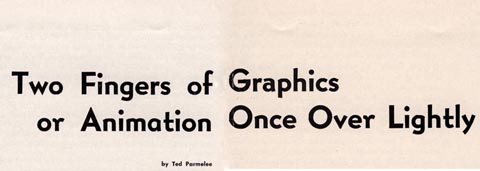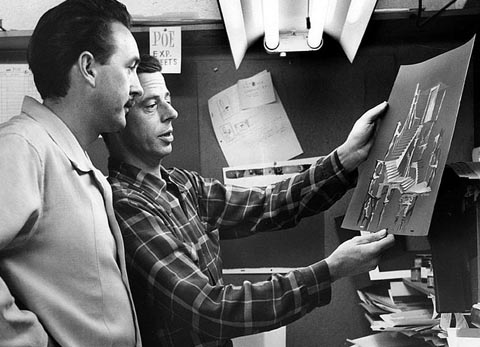

A 60-Year-Old Article is More Relevant Than Ever

Ted Parmelee (pictured above, right) is perhaps best remembered today as the director of UPA’s The Tell-Tale Heart, but his career in animation stretched from Pinocchio through Rocky & Bullwinkle and included lots of fine work in TV commercials and industrial films inbetween.
While browsing through some files related to my book Cartoon Modern, I stumbled onto scans of an article that Parmelee had written in the mid-1950s. The piece, which I’ve reprinted below, smartly sums up many of the issues that progressive animation artists faced in the 1950s. For example, Parmelee argued that Disney’s heavy reliance on live-action was an artistic dead-end and countered every other development in art at the time:
All efforts were directed toward better drawing to produce a kind of reality from what had originally been a very simple and direct medium. They were so delighted to see it move, and pleased with a medium more plastic in the use of “time” that they became involved in trying to make it round, real and spacious as they could. This was exactly the same standard of “good” that made Aunt Matilda’s “real-genuine-oil painting” good. “The apples looked so sure-enough for real you coulda’ picked ’em right out of the painting.” For this the artists to the Italian Renaissance for aid and borrowed the know-how of several centuries of draughtmanship. It was only natural and practical thinking. If you have a new gadget, don’t you take it out and try it on anything handy? Finally you have it doing the things it was designed for so well that it just gets monotonous, so you have it attempting things it never was built for.
There is a strong correlation between Parmelee’s critique of Disney in the 1930s and ’40s, and today’s art form — only the technique has changed. Contemporary big budget CG features exhibit increasing sophistication in lighting, textures, character animation and effects, but to what effect? Realism has again been cast as an end, when it is only a means for expressing a personal artistic vision.
Parmelee credits World War II as the impetus for animators experimenting with new filmmaking techniques, storytelling approaches and graphic styles. He also hails the arrival of the TV commercial, in which the form’s brevity allowed artists to explore different approaches for communicating with audiences.
Thankfully today’s animation medium is diverse enough that there is tons of experimentation happening, even moreso than in the 1950s. Parmelee, of course, anticipated this when he wrote that the single biggest improvement awaiting the industry “would be a decisive change in the actual physical means for making animated pictures, a more fluid kind of thing. . . a thing that provided quicker results.” Indeed, digital animation software and techniques have proven to be the savior, and offer an improvement over old production methods, especially when used by artists for the purpose of expressing themselves.
Read Parmelee’s article by clicking on the image below:

